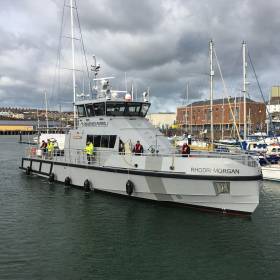Displaying items by tag: New FPV
Largest Fishing Port In Wales Welcomes FPV Rhodri Morgan
#fishing - The largest fishing port in Wales, at Milford Marina has welcomed the FPV Rhodri Morgan, one of five new fisheries patrol vessels taking to the waters in 2019.
The vessel was built by local company Mainstay Marine Solutions, and was named in Cardiff Bay in December, memorialising the former First Minister Rhodri Morgan.
At 26 metres long, weighing 75 tons, the vessel carries 11,000 litres of fuel. It also has room for a 6.5 metre sea-boat. It was built, along with four other vessels, to replace the previous fleet. This fleet will patrol Welsh waters looking for illegal fishing activity.
Melanie Durney, Docks and Marina Manager, Milford Marina, commented: “As Wales’ largest fishing port, we are honoured to have the FPV Rhodri Morgan here in the marina. It is an impressive vessel, and we are pleased to see that it will be part of the fleet patrolling the Welsh fishing grounds.”
The marina which is on the Milford Haven estuary is where the Port of Milford Haven is the UK’s top energy port and Wales’ busiest port handling around 20% of Britain’s seaborne trade in oil and gas. It is widely recognised in the industry as the energy capital of the UK in addition to a ferryport in Pembroke where Irish Ferries operate to Rosslare Harbour.





























































